Discover 17 majestic animals in Tongass National Forest we saw on our hikes! Alaska's biodiversity hotspot.
Wonder what animals in Tongass National Forest you could see on a hike? Read on!
Situated in the picturesque Alaskan landscape, Tongass boasts the richest biodiversity in the US, sheltering an awe-inspiring array of wildlife. From Bald Eagles soaring in the sky to Brown Bears ambling through the forests, the diverse ecosystem is a treasure trove for wildlife enthusiasts.
As avid hikers, our journey through the forest trails was nothing short of extraordinary, filled with awe and respect for this rich wilderness.
In the heart of the largest temperate rainforest, every footstep revealed a new spectacle, truly showcasing the importance of preserving our natural habitats.
Understanding the Tongass Landscape
Are you a passionate hiker and wildlife enthusiast setting sights on exploring the captivating Tongass National Forest? Here’s a little secret: the magic of Tongass unfolds best when you tread the lesser-travelled paths, venturing deep into the heart of the wilderness.
The extensive trail system serves as an open invitation to embrace nature, witness wildlife, and create memories of a lifetime.
Let’s embark on this journey by navigating the most popular trails: Mendenhall Glacier Recreation Area, West Glacier Trail, and The Deer Mountain Trail. Each of these offers unique sights, bringing you face-to-face with the intriguing “animals in the Tongass National Forest.”
The Mendenhall Glacier Recreation Area is an exquisite jewel in the crown of Tongass. The main attraction, undoubtedly, is the glacier itself. The trails around this stunning glacier, ranging from easy to strenuous, provide ample opportunities for wildlife encounters.
Marvel at the bears hunting salmon or gaze at beavers working diligently on their dams, all against the stunning backdrop of the glacier.
Next is the West Glacier Trail. As an avid hiker, I can vouch for its raw and untouched beauty. The strenuous, often muddy and rough terrain leads to a beautiful ice cave at the end, rewarding those who brave its path. The area is rich in birdlife, providing chances to spot bald eagles, ravens, and various songbirds.
The Deer Mountain Trail offers an exhilarating experience with its steep ascent, culminating in a panoramic view of the surrounding landscape. It’s a haven for spotting Sitka black-tailed deer, mountain goats, and if you’re lucky, maybe even a moose.
Selecting the right trail for wildlife viewing is a delicate art, hinging on factors like season, time of day, and your physical fitness. Remember, patience is the key to unlocking the best experiences. Wildlife viewing is a game of waiting and watching, of silent footsteps and hushed whispers. It’s a ballet of balance between exploration and respect for the environment, a dance that Tongass choreographs to perfection.
Animal Spotting in Tongass
In Tongass National Forest, every trail beckons with the allure of wildlife sightings – majestic Bald Eagles, elusive wolves, nimble Mountain Goats, and powerful bears. Each encounter is a marvel, etching unforgettable memories in this Alaskan wilderness.
Sitka Black-Tailed Deer
The Sitka Black-Tailed Deer, a graceful, agile species native to the Pacific Northwest, is a frequent sight within the majestic expanse of Tongass National Forest.
Adapted to the dense rainforests, they thrive in the moss-laden, misty trails of Tongass, their unique behavior adding an intriguing charm to the landscape.
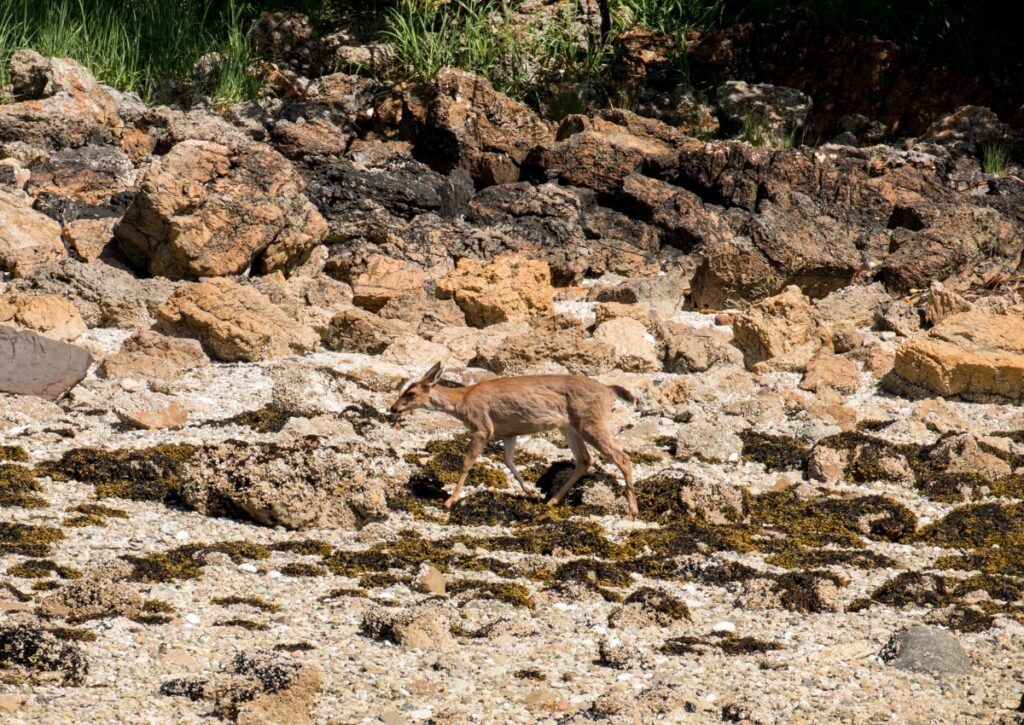
The Deer Mountain Trail is aptly named, as it is a favored habitat of these deer. As you traverse this trail, it’s not unusual to see a flash of their characteristic black tails disappearing into the forest, a testament to their elusive and watchful nature.
During one particular hike, as the sun was gently setting, bathing the trail in an ethereal glow, we experienced a profound encounter with a doe and her fawn.
They cautiously crossed our path, pausing briefly to acknowledge our presence. It was a humbling moment, one that embodies the privilege of sharing these trails with the fascinating wildlife of Tongass.
Bald Eagles
In the heart of the Tongass National Forest, the majestic Bald Eagle rules the sky. With their striking white heads, sharp yellow beaks, and impressive wingspan, they are a remarkable sight to behold.
As America’s national bird, they are symbols of strength and freedom, their presence adding an undeniable aura to the landscape.
The Anan Wildlife Observatory Trail offers a promising platform to view these spectacular birds. Amid the lush canopy, these powerful raptors perch high above, scanning the terrain for their next meal.
On a sunny morning hike, we were fortunate to witness an unforgettable display. From our vantage point, we spotted an eagle circling overhead, then plunging with breathtaking precision into the clear water.
It emerged triumphant, clutching a writhing salmon in its talons. In that singular moment, the raw prowess and elegance of nature unfolded before us, imprinting an everlasting image of the wonders housed within Tongass.
Brown and Black Bears
The Brown and Black Bears are the quintessential symbol of the wilderness in Tongass National Forest. The imposing Brown Bears, with their muscular hump and long, sharp claws, often frequent the riverbanks, in search of salmon.
The smaller, yet equally fascinating Black Bears, are adapted climbers, often sighted navigating the forest’s dense trees.
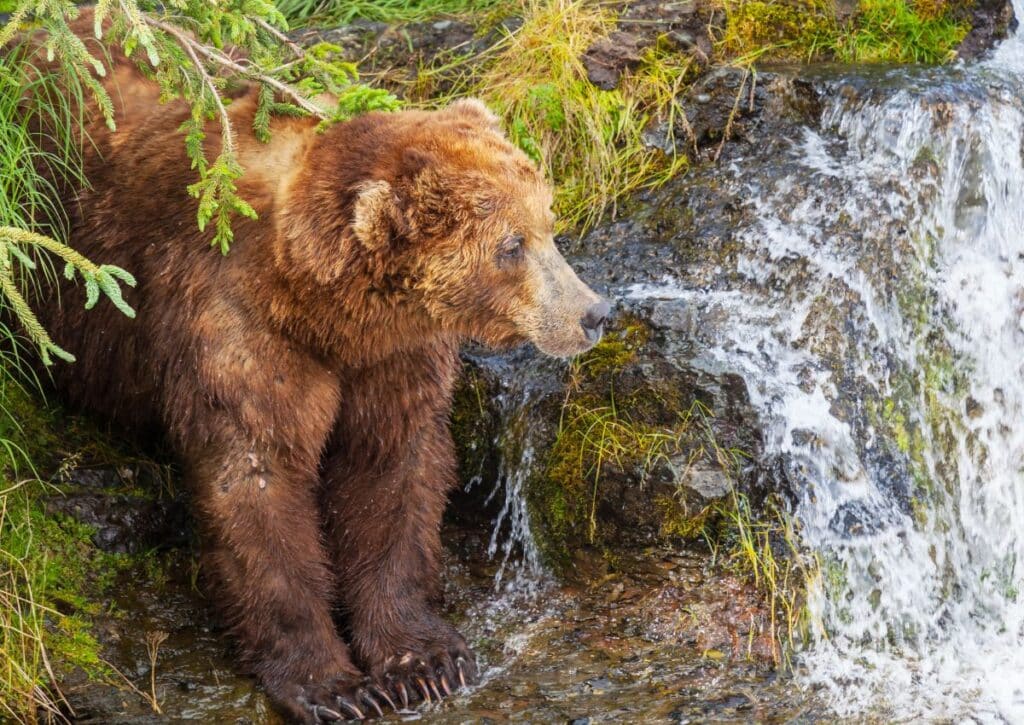
The Pack Creek Bear Viewing Area is a prime location for observing these magnificent creatures in their natural habitat. The trails around this area provide ample opportunities for sighting these mammals, albeit with a safe and respectful distance.
During a late summer hike, as the salmon run was at its peak, we had a thrilling encounter. A massive Brown Bear emerged from the foliage, moving towards the river. Silhouetted against the water, it plunged its head and resurfaced with a salmon, offering us an awe-inspiring glimpse into the primal spectacle of life in the Tongass National Forest.
Moose
The Moose, a truly iconic figure in the Alaskan wilderness, is a sight to behold within the sprawling Tongass National Forest.
The largest member of the deer family, Moose are distinctive with their long, bulbous noses, humped shoulders, and, in males, the enormous, broad antlers.
Though less frequently seen than other animals due to their preference for the forest’s remote regions, Moose are occasionally sighted along the quieter trails, often near bodies of water.
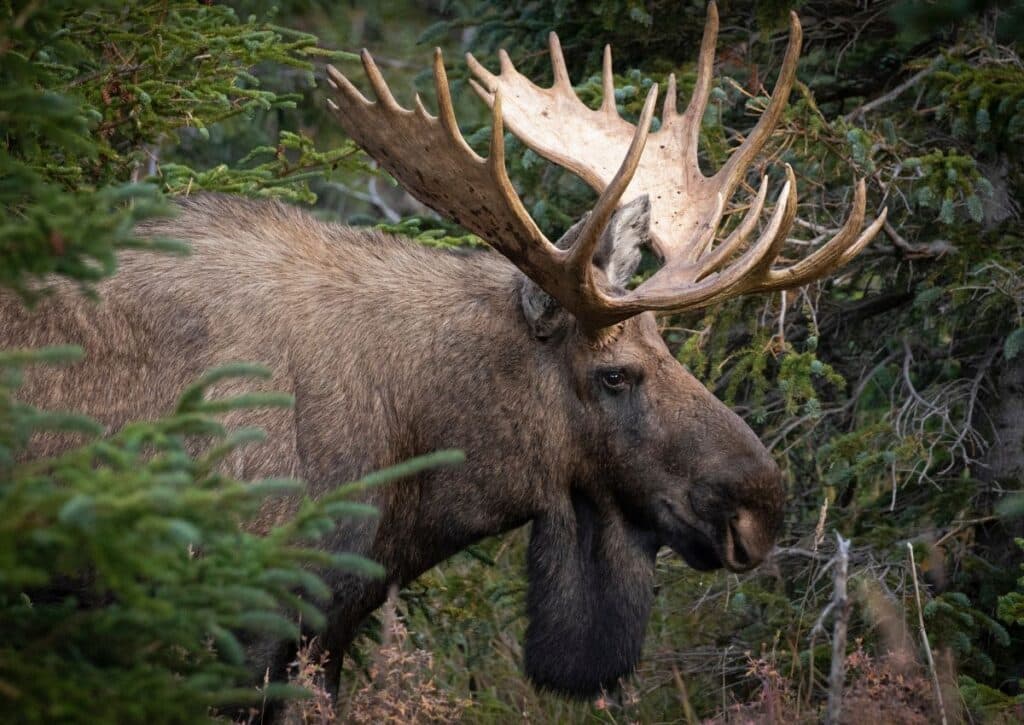
One such trail led us to a rare, magnificent encounter. Walking along the outskirts of a small lake, the rustling foliage alerted us to a nearby presence. From the thickets emerged a male Moose, his massive antlers silhouetted against the setting sun.
He paused by the water’s edge, granting us a few mesmerizing moments before he disappeared silently into the forest again. An encounter such as this, serves as a poignant reminder of the grandeur that awaits within the serene trails of Tongass National Forest.
Mountain Goats
In the rugged, high-altitude terrains of Tongass National Forest, Mountain Goats assert their dominance.
Characterized by their thick, white coats, black horns, and an extraordinary aptitude for steep cliffs, these creatures are truly designed for life at the edge.
High above the forest floor, they are often seen along the precipitous mountain trails, their nimble movements a fascinating spectacle against the stark, rocky backdrop.
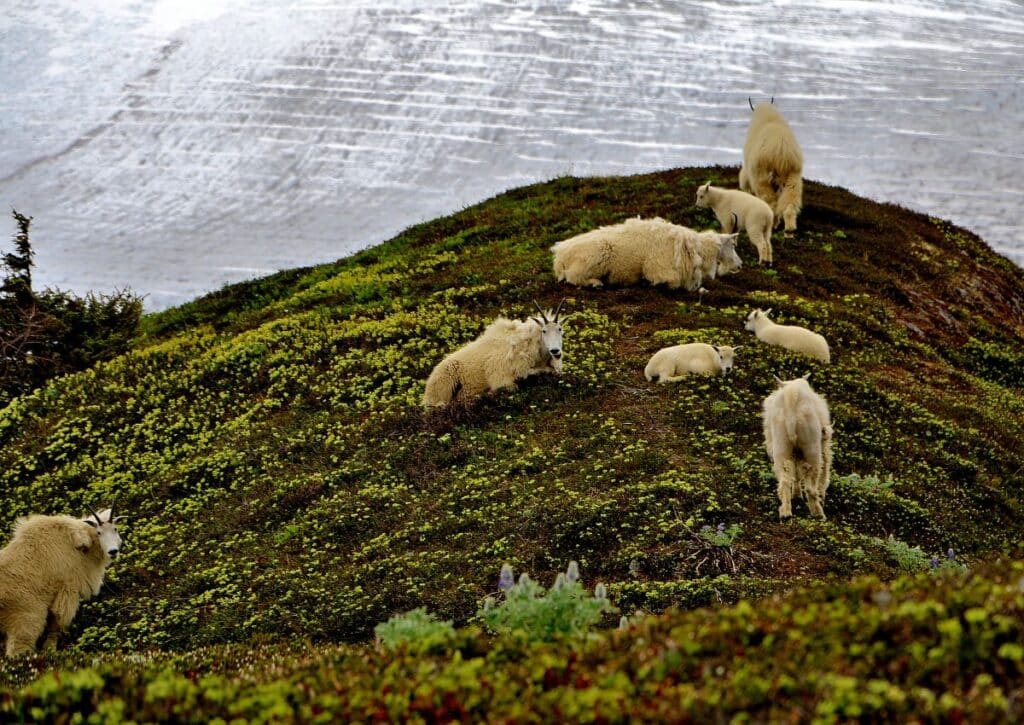
The Deer Mountain Trail offers stunning vistas, and, if you’re fortunate, a glimpse of these incredible animals.
One memorable encounter occurred during a challenging hike. As we rounded a steep bend, a small herd of Mountain Goats came into view, seemingly unfazed by the sheer drop beside them.
Their calm demeanour in such extreme conditions was profoundly humbling. Observing them in their lofty realm, undeterred by the precipitous environment, served as a vivid illustration of the stunning diversity and resilience of life in the Tongass National Forest.
Wolves
The elusive Gray Wolf, with its strikingly fierce eyes and sleek, powerful form, is another captivating inhabitant of Tongass National Forest. As social animals, they are often seen in packs, patrolling their territories and hunting in coordinated groups.
Wolf sightings, while rare, do occur along the forest’s quieter trails, where one can detect their paw prints in the soft earth or hear their hauntingly beautiful howls echoing through the valleys.
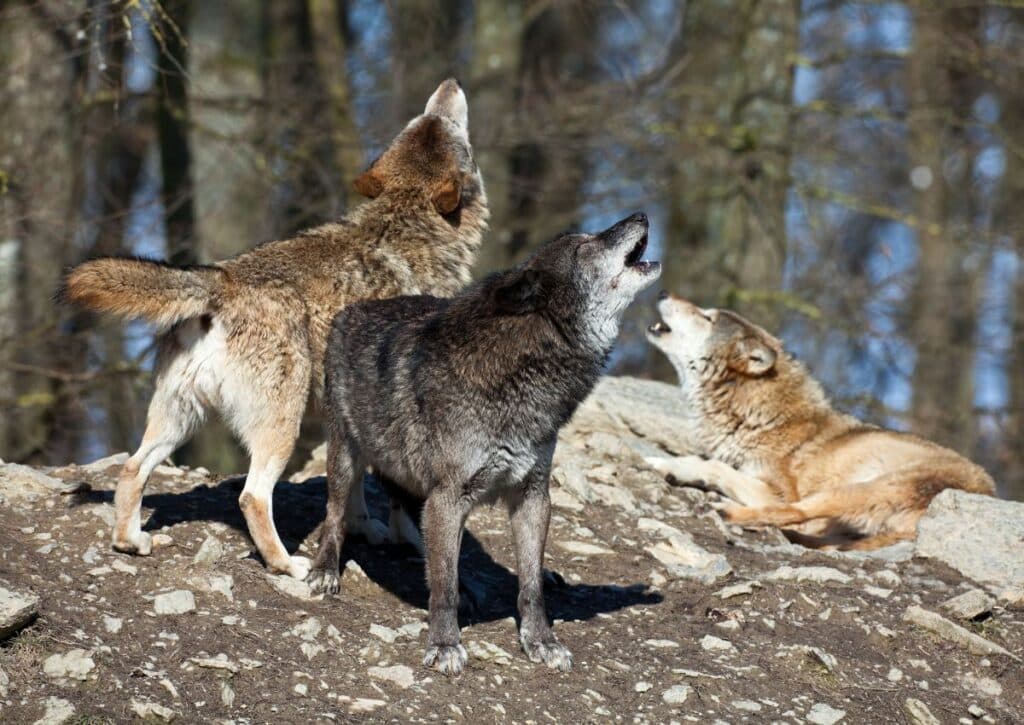
One frosty morning, as we hiked the remote trails near the Canadian border, we experienced a magical encounter. Through the dense fog, we discerned a pack of wolves emerging onto a clear patch.
Observing us with cautious curiosity, they maintained their distance, a testimony to the respect for boundaries in the wilderness. That fleeting connection, brief yet impactful, painted a vivid picture of the intricate balance of life that thrives within the silent expanses of Tongass National Forest.
Marine Wildlife of Tongass
Tongass’s aquatic realm, teeming with life, adds a unique dimension to its biodiversity. From the playful Harbor Seals to the spectacular sightings of Orcas and Humpback Whales, each encounter in the icy blue waters accentuates the forest’s rich tapestry of life, offering a magnificent marine spectacle.
The Harbor Seal
The Harbor Seal, with its rounded, torpedo-like body and curious, expressive eyes, is a delightful marine inhabitant of the Tongass National Forest.
These marine mammals, often seen lounging on icebergs or frolicking in the frigid waters, contribute to the rich biodiversity of the Alaskan marine ecosystem.
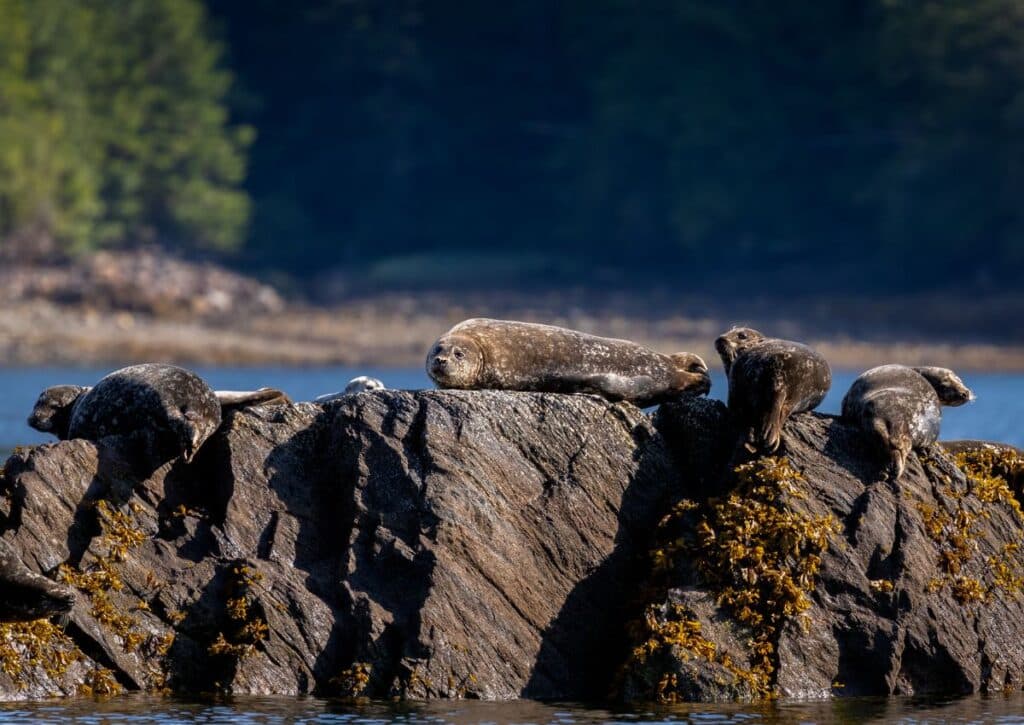
A prime spot for observing Harbor Seals is the Tracy Arm Fjord, a breathtakingly beautiful waterway flanked by towering cliffs and cascading waterfalls. Here, the seals find refuge on floating chunks of ice, using them as platforms for rest and rearing their pups.
During a boat tour, we had the pleasure of encountering a group of these charming creatures. At first, they eyed us with a cautious curiosity, their heads bobbing above the water’s surface.
As we silently drifted, maintaining a respectful distance, they relaxed, offering us a fascinating glimpse into their aquatic lives. Their presence adds a touch of magic to the wild, icy expanse of Tongass National Forest.
Orcas
The Orca, or Killer Whale, is one of the most captivating marine creatures that graces the waters surrounding Tongass National Forest. Their black and white bodies, large dorsal fins, and powerful, coordinated hunting techniques render them unmistakable.
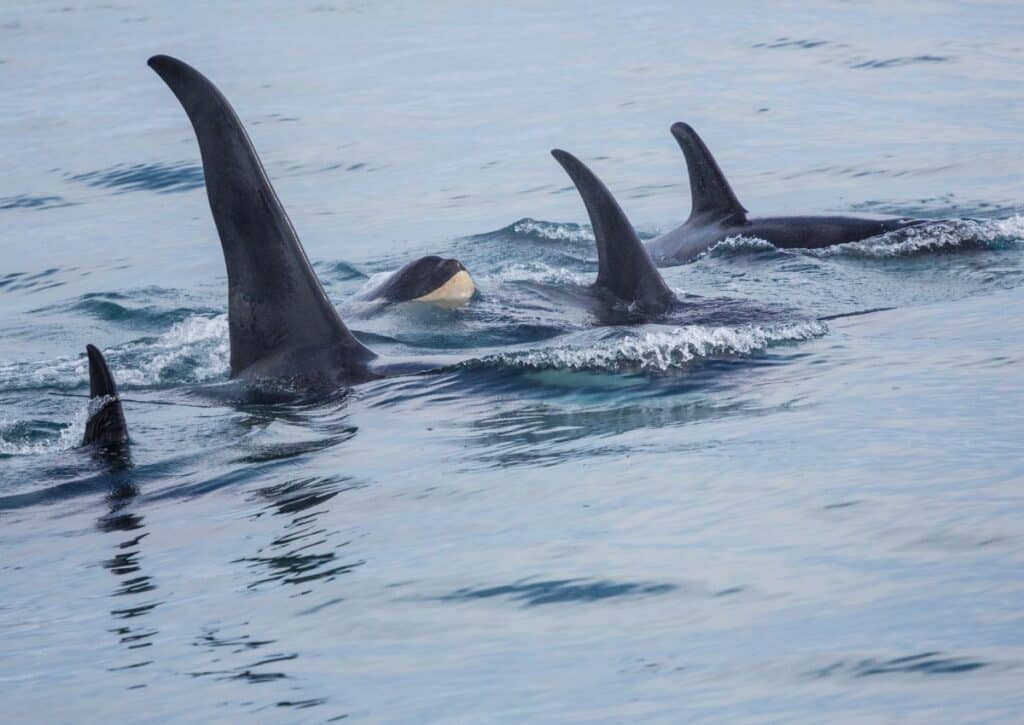
The waters around the forest, particularly near the Icy Strait, provide opportunities to witness these awe-inspiring animals in their natural habitat. Here, Orcas can be seen traversing the waters in search of their next meal, often salmon or even seals.
On a day of clear skies and calm seas, we set off on a whale-watching tour and were treated to an unforgettable spectacle. A pod of Orcas emerged near our boat, their fins slicing through the water’s surface with surprising grace.
Their synchronized surfacing and diving painted a mesmerizing tableau of life in the wild, highlighting the diversity and grandeur of marine wildlife in Tongass National Forest.
Humpback Whales
In the deep, icy waters surrounding Tongass National Forest, Humpback Whales rule the depths. Recognizable by their long pectoral fins and distinctive humps, these giants of the sea are an integral part of the marine ecosystem.
Frederick Sound, a marine passage near Tongass, offers an exceptional viewing platform. Here, during summer months, the Humpbacks converge to feed on krill and small fish, offering a spectacular display of their feeding techniques.
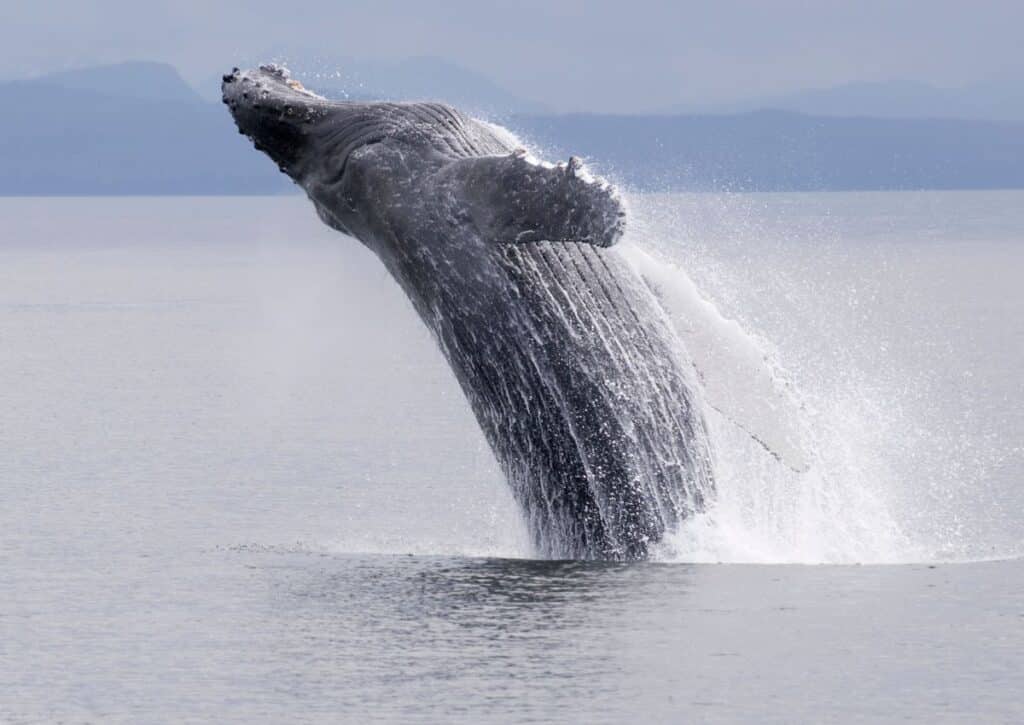
During one such summer expedition, we experienced a breathtaking encounter. A distant spray and a darkened patch on the water’s surface signalled the presence of a Humpback.
Suddenly, with a massive heave, it breached, its enormous body temporarily airborne before crashing back into the water, causing an impressive splash.
The sight of this magnificent creature, so immense yet so graceful, served as a reminder of the breathtaking spectacle of life that thrives within and around the Tongass National Forest.
Birdwatching in Tongass
In Tongass National Forest, birdwatchers are rewarded with a symphony of avian life. From the commanding Bald Eagles to the melodious songbirds, each species adds a note to the forest’s harmony. Their presence, a testament to the area’s biodiversity, creates an unforgettable birdwatching experience in the Alaskan wilderness.
Tongass National Forest offers a veritable paradise for birdwatchers. Each species adds a unique thread to the complex tapestry of life in this vibrant ecosystem. From the piercing cry of the Bald Eagle to the tuneful chorus of the songbirds, the forest reverberates with avian melodies.
Among the most intriguing of the forest’s bird species is the Marbled Murrelet. This petite, elusive seabird is a unique specimen due to its unusual nesting habits. Instead of breeding on coastal cliffs like other seabirds, Murrelets lay their eggs high in the forest’s old-growth trees, creating a fascinating bridge between the marine and terrestrial ecosystems.
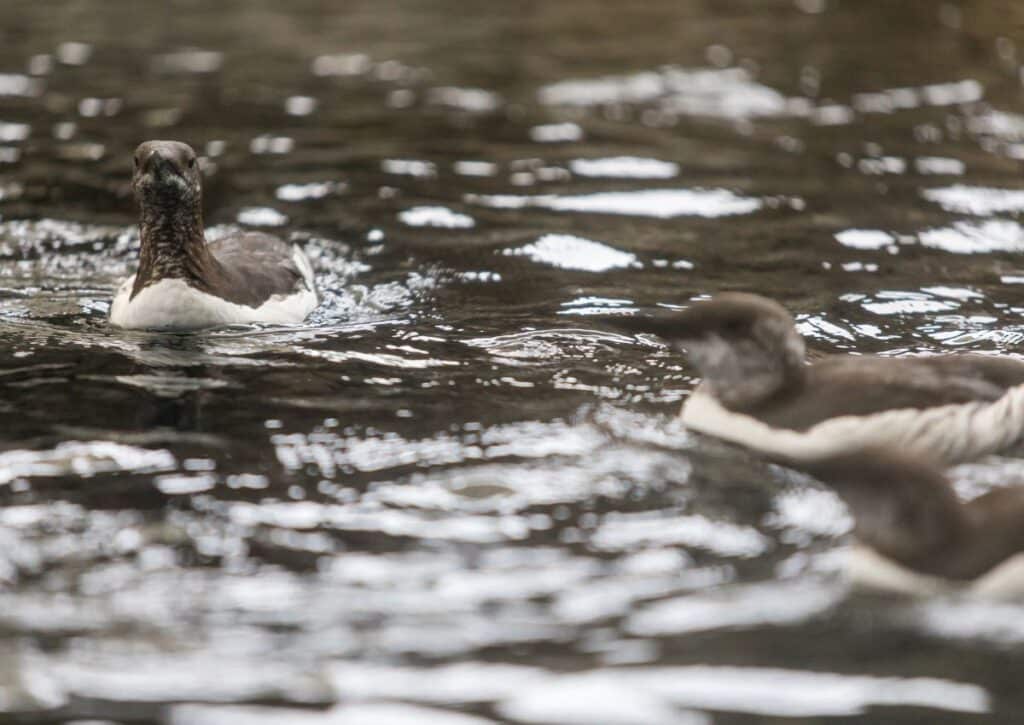
Spotting them during their rapid, low-flying forays over the water is a delight for any birdwatcher.
Another remarkable bird species found in Tongass is the Northern Goshawk. This raptor, with its piercing red eyes and swift, agile flight, is a master hunter. Goshawks are elusive and are best spotted in the forest’s quiet, remote areas, making any sighting a thrilling reward.
In addition to these rare species, one can also observe a variety of other birds like the Red-breasted Sapsucker, Steller’s Jay, and the Varied Thrush. Each sighting offers a unique insight into the rich avian biodiversity of the forest.
In essence, birdwatching in Tongass is an adventure that blends the joy of discovery with the serenity of nature. Each expedition, filled with the flutter of wings and a symphony of calls, deepens our appreciation for the vibrant avian life that thrives in this Alaskan wilderness.
Wildlife Hikes in Tongass National Forest
Tongass National Forest is a haven for nature lovers, with its sprawling landscapes and diverse ecosystems presenting a myriad of hiking opportunities. E
ach trail offers a unique experience, immersing hikers in the wilderness where the lines between man and nature blur.
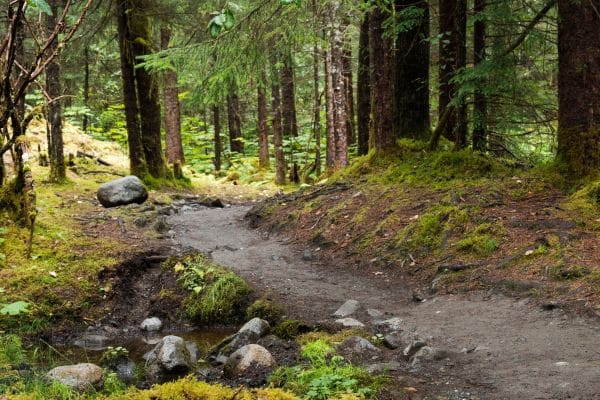
Whether you’re an amateur naturalist, a birdwatcher, or just someone seeking solitude in nature, the trails of Tongass beckon with the promise of wildlife encounters and breathtaking vistas.
1. Indian River Trail (8.5 miles round trip)
Meandering alongside the scenic Indian River, this trail offers abundant opportunities to spot the Sitka Black-Tailed Deer grazing near the riverbanks.
The soothing river sounds might occasionally be interrupted by the majestic call of Bald Eagles soaring overhead. Wolves are known to inhabit these parts, and their distant howls can add an ethereal atmosphere to your hike.
2. Deer Mountain Trail (6.7 miles round trip)
As the name suggests, this is another hotspot for encountering the Sitka Black-Tailed Deer. With panoramic views from the mountain’s ridge, you can often see Mountain Goats navigating the rocky outcrops.
The high vantage point also makes it easier to spot the likes of Brown and Black Bears below.
3. Rainbird Hiking Trail (1 mile round trip)
This relatively short trail is a birdwatcher’s paradise. Bald Eagles, alongside other native birds, are frequently seen here. The lush greenery also attracts the Sitka Black-Tailed Deer, making this trail a compact wildlife experience.
4. Carlanna Lake Trail (3.5 miles round trip)
Leading to the serene Carlanna Lake, this trail offers hikers a chance to spot Moose wading in the waters, especially during early mornings or late evenings. The pristine waters also attract various bird species, including the iconic Bald Eagle.
5. West Glacier Trail (7 miles round trip)
Venturing closer to the icy terrains, hikers can often spot Mountain Goats and even Wolves. The trail’s proximity to the glacier also means potential sightings of marine wildlife like Harbor Seals that often venture closer to glacier-fed waters.
6. Herring Cove Trail (3 miles round trip)
Positioned near the water, this trail offers a mix of both forest and marine life. The dense forested areas are home to Brown Bears, while the coast might reveal glimpses of Humpback Whales and Orcas, especially during migration seasons.
7. Nugget Falls Trail (2 miles round trip)
This trail, leading to the mesmerizing Nugget Falls, often has Brown Bears searching for fish, especially during the salmon spawning season.
The thunderous sound of the falls is often accompanied by the cries of various birds, making this a multisensory wildlife experience.
8. Ice Cave Trail (Distance varies)
Delving into the icy realms of Tongass, the Ice Cave Trail provides a unique setting where one might encounter the rare sight of Mountain Goats seeking shelter.
The glistening cave interiors, coupled with occasional wildlife, make this hike unforgettable.
9. Herbert Glacier Trail (8.6 miles round trip)
Navigating alongside the Herbert River leading to the magnificent glacier, hikers have a good chance of spotting Moose and Sitka Black-Tailed Deer by the riverbanks.
The echoing sounds from the glacier might sometimes be intermingled with the distant calls of wolves.
Safety Measures and Best Practices for Wildlife Viewing in Tongass
In Tongass National Forest, respectful and non-disruptive wildlife viewing is key to ensuring safety and preserving nature.
Safe Distance: Always maintain a safe distance from wildlife to avoid causing stress or eliciting a defensive reaction. If an animal alters its behavior due to your presence, you are too close.
Non-disruptive Viewing: Use binoculars or a telephoto lens to observe wildlife. This allows you to get a close-up view without encroaching on their space.
Quiet Presence: Keep noise levels to a minimum. Sudden sounds or movements can startle wildlife and disturb their natural behaviors.
Stay on Trails: To minimize impact on habitats, always stay on designated trails.
Don’t Feed Wildlife: Feeding wildlife can disrupt their natural diets and make them reliant on humans. It’s also illegal in many protected areas.
Leave No Trace: Carry out any trash to preserve the environment and protect the animals.
Respect: Remember, you’re a guest in their home. Treat wildlife with the same respect and consideration you’d want in your own home.
Patience: Wildlife viewing often requires patience. Wait quietly for them to appear and enjoy the peaceful surroundings.
By following these guidelines, you can ensure a safe, respectful and enjoyable wildlife viewing experience in Tongass National Forest.
End Notes
Our journey through Tongass National Forest was a symphony of experiences, where each encounter painted a vivid tableau of the forest’s rich biodiversity.
From the powerful gaze of the gray wolf to the graceful flight of the Bald Eagle, each moment deepened our reverence for this wild expanse.
The melodies of the songbirds and the distant spouting of humpback whales further amplified the forest’s harmony.
The respect we practiced while viewing wildlife served not only to protect these amazing creatures but also enriched our experience, reminding us of our role as guardians of the natural world.
Tongass is a testament to nature’s resilience and beauty, and our journey through its trails was nothing short of awe-inspiring.

